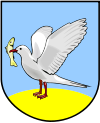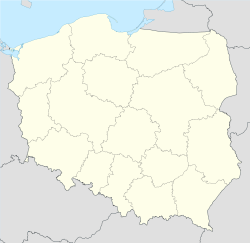- Gniew
-
Gniew Town view 
Flag
Coat of armsCoordinates: 53°50′0″N 18°50′0″E / 53.833333°N 18.833333°E Country  Poland
PolandVoivodeship Pomeranian County Tczew Gmina Gniew Established 13th century Town rights 1297 Government - Mayor Maria Gurzyńska Area - Total 6.75 km2 (2.6 sq mi) Elevation 47 m (154 ft) Population (2008) - Total 6,759 - Density 1,001.3/km2 (2,593.4/sq mi) Time zone CET (UTC+1) - Summer (DST) CEST (UTC+2) Postal code 83-140 Area code(s) +48 58 Car plates GTC Website http://www.gniew.pl Gniew [ɡɲef] (German: Mewe; Kashubian: Gniéw) is a town situated on the left bank of the Vistula River, in the Pomeranian Voivodeship, Poland. It is located at around 53°50′0″N 18°50′0″E / 53.833333°N 18.833333°ECoordinates: 53°50′0″N 18°50′0″E / 53.833333°N 18.833333°E.
Contents
History
The first recorded mentions of Gniew appear in written documents from the first half of the 13th century, one of which refers to the region as Terra Gymeu. The earliest name for the settlement was Gmiew, however, during the Middle Ages the name Wońsk was also used. The German name of Mewe for the town is still reflected on the coat of arms of the city, which bears the presence of a seagull (Möwe in German).
Beginning in the 10th century, the region belonged to the Polan tribe and was part of Gdańsk Pomerania. After the division of Poland by Bolesław Krzywousty, Gniew fell to the castellany of Starogard Gdański. The land later fell to the Princes of Świecie and in 1229 Prince Sambor and Swantopolk II of Pomerania granted it to the Cistercian abbey in Oliwa. In the second half of the 13th century, Sambor retook Gniew from the Cistercians and in 1276 bestowed it on the Teutonic Knights. Their claim was formally recognized by Mestwin II of Pomerania in 1282, and the city became the first stronghold of the Teutonic Order on the left riverside of the Vistula. A castle was built as a result of this important strategic location, and in 1297 the Teutonic Knights gave Gniew town privileges.
The city exchanged hands various times between 1410-1466 until it became part of the Polish province of Royal Prussia following the Second Peace of Thorn (1466). In 1626, during the Swedish-Polish War, a battle between the Polish-Lithuanian Commonwealth and Swedish forces was fought in the area of Gniew, resulting in a victory for the army of King Gustavus Adolphus of Sweden, and only the second historic defeat for the Polish hussars. In the second half of the 17th century, prior to becoming King of Poland, John III Sobieski served as the local district governor (starost) of Gniew and built the Marysienka Palace for his wife, Maria Kazimiera.
Gniew was annexed by the Kingdom of Prussia during the Partitions of Poland and became part of the German Empire in 1871. With the defeat of Imperial Germany in World War I, Gniew became part of the Polish Corridor according to the Treaty of Versailles. This date is celebrated in Gniew till today as liberation from Prussian oppression and end of 148 years of attempts to destroy Polish existence[1]
After the First World War number of ethnic Germans within the town decreased.[2][Full citation needed] During World War II the castle was used by Nazi Germany as a concentration camp for the ethnically cleansed Polish population of Tczew and the surrounding area.
Main Sights
The most notable landmark of the town is the Ordensburg castle built by the Teutonic Order at the turn of the 14th century, as well as Marysienka's Palace, built during the second half of the 17th century. The city also boasts a well preserved medieval old town, with buildings dating from the 15th to 19th century and a Gothic church dating to the 14th century.
International relations
Twin towns — Sister cities
Gniew is twinned with:
References
- ^ Dziewięćdziesiąta pierwsza rocznica wolnego Gniewu
- ^ Kotowski, Albert S. (1998) (in German). Polens Politik gegenüber seiner deutschen Minderheit 1919-1939. Forschungsstelle Ostmitteleuropa, University of Dortmund. p. 55. ISBN 3-447-03997-3. http://books.google.de/books?id=KVg_tMs_ZPIC&pg=PA365&dq=Goetheschule+Graudenz&hl=de&ei=j-AlTdz_JsvDswaVy9DMAg&sa=X&oi=book_result&ct=result&resnum=6&ved=0CDoQ6AEwBTgo#v=onepage&q=%20Graudenz&f=false.
External links
- Municipal website (Polish)
- Gniew Castle
Town and seat Gniew
Villages Aplinki • Brody • Ciepłe • Cierzpice • Dąbrówka • Gogolewo • Jaźwiska • Jeleń • Kolonia Ostrowicka • Kuchnia • Kursztyn • Mała Karczma • Nicponia • Opalenie • Ostrowite • Piaseckie Pola • Piaseczno • Pieniążkowo • Polskie Gronowo • Półwieś • Rakowiec • Stary Młyn • Szprudowo • Tymawa • Widlice • Wielkie Walichnowy • Wielkie Wyręby • WłosienicaCategories:- Cities and towns in Pomeranian Voivodeship
- Tczew County
- Former castles
- Castles of the Teutonic Knights
- Castles in Poland
Wikimedia Foundation. 2010.


